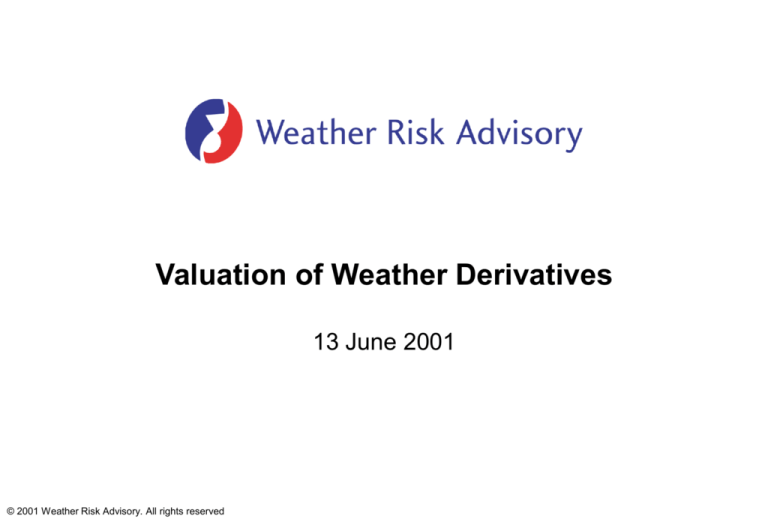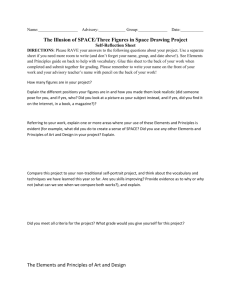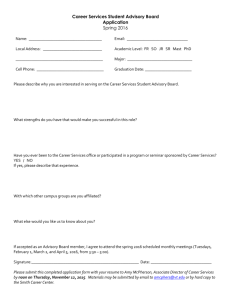
Valuation of Weather Derivatives
13 June 2001
© 2001 Weather Risk Advisory. All rights reserved
Temperature
About a year ago, there was a rumour that Coca-Cola the soft drink
company, had plans for a vending machine, which varies the price for a
drink according to outside temperature. The company denied the plans
but we can see the logic behind the idea. One of the main causes of
uncertainties in cash flow is the weather. Temperature in this case. In
the hot summers of 1976 and 1995, the machine could have charged a
fortune
A regulated power utility company must fix their price for electricity for a
certain period. Prices can only be increased with permission of the
regulators. Yet, power consumption will be low in warm winters. There is a
source of uncertainty of incoming cash flow: temperature
© 2001 Weather Risk Advisory. All rights reserved
Rain
Agriculture companies have been aware of weather risk for a long time. The
major climatic factor which influences crop growth is rainfall
“Excess moisture continues to be a problem, particularly to later seed
crops.”
“… but rainfall over the weekend brought haying to a standstill.”
“Excess moisture has taken its toll in some areas as crops in low lying lands
have drowned out…”
“…heavy rains causing some localized crop damage”
© 2001 Weather Risk Advisory. All rights reserved
Wind
One source of alternative energy is on the rise:
Wind farms are being built, not only in this country but also in Europe. Their
exposure to lack of wind (and also an excess of wind) is obvious
No wind, no electricity, no money
© 2001 Weather Risk Advisory. All rights reserved
Weather Derivatives
© 2001 Weather Risk Advisory. All rights reserved
Example One: Description
Swap
• I shall pay you USD 5,000 for every degree Celsius the average
temperature at Heathrow airport is below 18 on any day in the
observation period (1 Nov 2001 - 31 Mar 2002)
• In exchange, you pay me a fixed amount
• Of course, these two payments are netted and the difference paid at the
end of the contract period
• Netted pay-out is limited to USD 1,000,000
© 2001 Weather Risk Advisory. All rights reserved
Example One: Description 2
Option
• As above, however, cash flow only occurs when the differential is positive
(or negative)
• Plus an up-front premium payment
• Pay-outs limited to USD 1,000,000
© 2001 Weather Risk Advisory. All rights reserved
Example One: Index
•
Heating Degree Days (HDD)
•
On each day of the observation period
1.
Calculate the number of degrees the average temperature is below
18 degrees (or other reference temperature as defined in
contract)
2. Sum them up (and maybe round according to contract details)
•
Formula
HDD 18 Tk
n
k 1
© 2001 Weather Risk Advisory. All rights reserved
Index Calculation: Numerical Example
Date
01-Nov-99
02-Nov-99
03-Nov-99
04-Nov-99
05-Nov-99
06-Nov-99
…
29-Mar-00
30-Mar-00
31-Mar-00
© 2001 Weather Risk Advisory. All rights reserved
Max T
17.3
13.8
14.6
17.2
21.3
16.6
Min T
12.2
9.9
5.4
11.7
16.3
12.9
7.1
8.2
10
3.7
5
5
Avg T Daily HDD
14.75
3.25
11.85
6.15
10.00
8.00
14.45
3.55
18.80
0.00
14.75
3.25
…
5.40
12.60
6.60
11.40
7.50
10.50
=======
1664.7
Example One: Trade
Swap
Calculate Differential = Fixed swap level - HDD index
• When differential is positive, receive USD 5,000 * differential
• When negative, pay USD 5,000 * differential
Put Option
Calculate Differential = Fixed swap level - HDD index
• When differential is positive, receive USD 5,000 * differential
• When negative, no cash flow
Up to the value of the limit
© 2001 Weather Risk Advisory. All rights reserved
Example One: Payout Formula
Swap
Put Option
max min HDD strike, limit ,limit
max min HDD strike , limit ,limit
© 2001 Weather Risk Advisory. All rights reserved
Example One: Underlying
• Daily average temperature
or
• The index (HDD)
A model is needed for either the temperature process or the index
© 2001 Weather Risk Advisory. All rights reserved
Example Two: Description
• Pay me USD 500,000 for every day in the observation period
(1 Jul 2001 - 31 Aug 2001)
on which rainfall is above 0.1 inch
at Des Moines, Iowa, International Airport
• In exchange for a fixed up-front premium payment (call option)
• Pay-out limited to USD 2,500,000
© 2001 Weather Risk Advisory. All rights reserved
Example Two: Index
• Count the number of days in the observation period on which the rainfall
is above the specified threshold
© 2001 Weather Risk Advisory. All rights reserved
Index Calculation: Numerical Example
Trigger
Date
1-Jul-00
2-Jul-00
3-Jul-00
4-Jul-00
5-Jul-00
6-Jul-00
7-Jul-00
8-Jul-00
9-Jul-00
10-Jul-00
© 2001 Weather Risk Advisory. All rights reserved
0.10
Rainfall Event Cnt
0
0.00
0
0.00
0
0.00
1
0.74
1
0.41
0
0.00
1
0.61
0
0.07
0
0.00
0
0.00
=======
3
Example Two: Trade
Call Option
Call option with strike 0 and tick size USD 5,000
•
•
Pay an up-front premium payment
Calculate Differential = rain index – strike
1. When differential is positive, receive USD 5,000 * differential
2. When differential is zero, no cash flow
•
Maximum pay-out USD 2,500,000
© 2001 Weather Risk Advisory. All rights reserved
Example Two: Underlying
• Daily rainfall
or
• The index
Again, a model is needed for either rainfall process or the index
© 2001 Weather Risk Advisory. All rights reserved
Exotic Structures
Further complications and additions
• Dual trigger event: temperature and rain
• Multi-station trades: baskets or multi-station events
• Event only counted when it occurs on two or three consecutive days
© 2001 Weather Risk Advisory. All rights reserved
Models
© 2001 Weather Risk Advisory. All rights reserved
Burn Rate Analysis
• Clean, reconstruct and de-trend the data
• Calculate the index (HDD, etc.) from historical annual observations
• Calculate the resulting trade pay-off for every year
• Calculate the average of the trade pay-offs
• Discount back from settlement date to today
• Add risk premium
© 2001 Weather Risk Advisory. All rights reserved
Data Modification
• Clean: fill in missing data and correct errors
• Reconstruct: modify data to account for change of equipment, change of
location
• De-trend: remove trends due to global warming or urbanisation
© 2001 Weather Risk Advisory. All rights reserved
Burn Rate Analysis : Numerical Example
Strike
Season
1990/1991
1991/1992
1992/1993
1993/1994
1994/1995
1995/1996
1996/1997
1997/1998
1998/1999
1999/2000
Mean
© 2001 Weather Risk Advisory. All rights reserved
1700
Index
Swap
Option
1846
-146
0
1781
-81
0
1735
-35
0
1766
-66
0
1572
128
128
1948
-248
0
1807
-107
0
1538
162
162
1675
25
25
1665
35
35
=======================
1733.3
-33.3
35
Burn Rate Analysis : Pros and Cons
Positive
+ Simple to implement
+ Easy to understand
+ Suitable for portfolio valuation
Negative
- Low probability events ignored or unreliably estimated
- General problem is that in such a low sample, a single observation can
strongly influence the option value
- Unclear selection and calculation of risk parameters
© 2001 Weather Risk Advisory. All rights reserved
Stochastic Models for Weather Paths
• Choose a stochastic model for daily observations
• Estimate the model parameters using weather data
• Simulate a weather path
• Calculate index and option value for this path (=simulated observation)
• Repeat many times and calculate mean
• Discount back to today
© 2001 Weather Risk Advisory. All rights reserved
Stochastic Models: Examples
• Auto-Regression (AR): use the weighted sum of previous days’
temperatures for the estimation of next day’s temperature
• Mean-reverting diffusion (MR): a Markov model with pull-back to the
mean
• Cao-Wei: a variation of AR
• Bob Dischel: a variation of MR
© 2001 Weather Risk Advisory. All rights reserved
Estimators
• Moment estimator
find parameters based on observed and model moments,
e.g. mean and standard deviation
• Maximum-likelihood estimator
find parameters which are most likely, based on observed data
© 2001 Weather Risk Advisory. All rights reserved
Example: Auto-regression
Equation
T n n 1T n 1 2T n 2 n
© 2001 Weather Risk Advisory. All rights reserved
Example: Mean-reverting Diffusion
• Equation
dT t a t T t dt dW t
or
• alternatively
dT t t dt at T t dt dW t
© 2001 Weather Risk Advisory. All rights reserved
Stochastic Models: Pros and Cons
Positive
+ One (model) fits all (indexes)
Positive/negative
± Portfolio risk management possible but may have associated problems
(multi-location correlation)
Negative
- Slow or inaccurate (in particular for low-event contracts)
- Harder to implement
© 2001 Weather Risk Advisory. All rights reserved
Weather Forecasts
© 2001 Weather Risk Advisory. All rights reserved
Long-range Weather Forecasts
• So far, the approach has been to base an estimation of the future on past
observations
• With weather, can we do better and use forecasts?
• And how could we integrate them into pricing models?
© 2001 Weather Risk Advisory. All rights reserved
Ensemble Forecasting - Probability Forecasts
• Ensemble forecasting has been developed over the past decade and has
lead to a large increase in the accuracy and usability of medium-range
forecasts
• The technique is now being applied to longer range forecasts
• Ensemble forecasting uses the sensitivity of forecasts to the initial
conditions to provide probability forecasts
Ensemble Forecasting
By perturbating the initial conditions of a forecast and rerunning it multiple times, a range of forecasts for the
same time period are produced. These can be used to
produce probability distributions of possible outcomes.
© 2001 Weather Risk Advisory. All rights reserved
Climate Prediction Center Ensemble Forecasts
• They have been found to be reliable in El Nino and La Nina years for
predicting the US climate, but have a tendency to be too cold
• CPC predicts whether temperature and rainfall will be above, below or
near normal for 30 and 90 day periods
• But El Nino does not effect Europe so this approach cannot be used
© 2001 Weather Risk Advisory. All rights reserved
Forecast Format
• Forecasts are expressed as the probability anomaly of the observation
• Three classes - above - near - or below normal
• Forecast probability anomaly is the difference between the actual
forecast probability of the verifying observation falling in a given
category and its climatological value of 33.3%
• Mean temperature and total precipitation
© 2001 Weather Risk Advisory. All rights reserved
Forecast Format: Example
CL
A5
A 10
B5
B 10
Below
Near
Above
33.3%
33.3%
33.3%
28.3%
33.3%
38.3%
23.3%
33.3%
43.3%
38.3%
33.3%
28.3%
43.3%
33.3%
23.3%
© 2001 Weather Risk Advisory. All rights reserved
Integration of Forecasts into Pricing Models
• Adjust model parameters so that model probability distribution matches
forecast
• Read our paper for more details
© 2001 Weather Risk Advisory. All rights reserved
Summary and Conclusions
© 2001 Weather Risk Advisory. All rights reserved
Theoretical Considerations of Modelling Approaches
• Arbitrage-free pricing approach (risk-neutral valuation) as used in
standard derivatives industry
price = risk-neutral value (+profit margin)
• Actuarial approach
price = statistical value + risk premium (+ profit margin)
Actuarial approach currently used in weather derivatives industry and
insurance
• Shadow-price approach
© 2001 Weather Risk Advisory. All rights reserved
Summary
• A market for weather derivatives is being established
• Typical examples of currently traded products
• Untradable weather risk will probably remain, in particular extremes.
They will remain insurance cases
• Two modelling approaches, both have their strengths and weaknesses
• Forecasts
• Actuarial approach
© 2001 Weather Risk Advisory. All rights reserved
Two Challenges Ahead
• Transition to arbitrage-free approach (when markets become liquid, take
future contracts and back out a risk-free temperature curve, take
options and work out a volatility surface)
• Portfolio management of mixed books (e.g. power and weather), to give
you an idea of that challenge, even portfolio management of weather
books is not fully solved
© 2001 Weather Risk Advisory. All rights reserved
References
© 2001 Weather Risk Advisory. All rights reserved
References
•
M. Cao and Wei, J.: Equilibrium Valuation of Weather Derivatives,
Working Paper.
•
B. Dischel: At Last: A Model for Weather Risk, EPRM Mar 1999.
•
G. Considine: Introduction to Weather Derivatives, Working Paper.
•
I. Nelken: Weather Derivatives – Pricing and Hedging, Working Paper.
•
L. Zeng: Weather Derivatives and Weather Insurance: Bulletin of the
American Meteorological Society, Vol. 81, No.9, Sep 2000.
© 2001 Weather Risk Advisory. All rights reserved
www.WeatherRiskAdvisory.com
info@WeatherRiskAdvisory.com
tel: +44 (0) 1954 206246
fax: +44 (0) 1954 206250
© 2001 Weather Risk Advisory. All rights reserved





